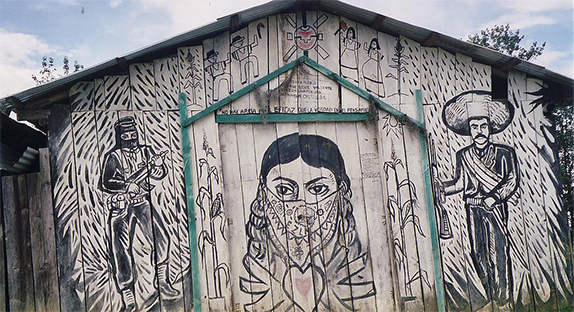
Tens of thousands of indigenous protestors and their allies in the southern Mexican state of Chiapas took to the streets on Saturday, October 12. While the date is officially called Dia de La Raza and celebrated as the Latin American equivalent of the Columbus Day holiday in the United States, indigenous Mayans in Chiapas tagged another name on the day: 521 Years of Indigenous, Black, Campesino and Popular Resistance.
In different zones of Chiapas, from the cool highlands of San Cristobal de las Casas to the tropical rainforest around the ancient ruins of Palenque, residents blockaded highways and large commercial stores, participated in massive demonstrations and, in the case of Palenque, draped a red and black flag on city hall.
“We stress the importance of sharing our thinking and participating with our voice and concrete actions in the destiny of our country,” the protestors declared in a statement. “That’s why we say, here we are.”
The statement continued, “We have walked in a peaceful way, building our force in consultation with the peoples, men and women, in the collective work of the assemblies.”
A tradition since the hemispheric protests against the Columbus holiday in 1992, this year’s mobilization, or Day of Indigenous Dignity as it is also known, supported the cause of striking teachers and opposition to educational and other reforms promoted by the administration of President Enrique Pena Nieto and his political allies in the Pact for Mexico.
In Chiapas, the biggest protest was in the state capital of Tuxtla Gutierrez, where an estimated 50,000 teachers, students, parents, and other members of the public turned out.
“This march is headed to the national strike,” was among the chants heard in the streets. Saturday’s action in Tuxtla Gutierrez was widely considered a warm-up to the intensification of nationwide protests in the coming days.
Locally, tensions are on the rise. Two teachers Chiapas teachers, Tirso Cruz Yuca and Rodolfo Lopez Toledo, have been reportedly murdered in the past 15 days. Meanwhile, some parents contend that local government officials are offering parents between 100 to 300 pesos to participate in a counter-demonstration planned for October 14.
In Ocosingo, Mayor Octavio Albores Cruz accused demonstrators, who numbered an estimated 10,000, of spray painting the city hall and causing property damages.
Organizations supporting the October 12 Chiapas protest included the Independent Communities of Ocosingo, Eijdo San Francisco, Our Corn People, the National Struggle Front for Socialism, different offshoots of the historic Union of Unions, and sections of the official National Union of Education Workers and the National Coordinator of Education Workers (CNTE).
“We declare to the people of Chiapas that this protest action is to express our energetic rejection of the poorly-named education, energy, tax and agrarian reforms,” the organizations said.
Chiapas was far from alone in commemorating October 12 as a day of indigenous resistance.
In the Michoacan state capital of Morelia, hundreds of indigenous students from the Michoacan University of San Nicolas de Hidalgo staged a march from the statue of President Lazaro Cardenas to government offices. Joined by representatives from the CNTE, social organizations and 26 indigenous municipalities, the students called for an end to inequality, exploitation and oppression.
Later, the leader of the Zapatista Purepecha Nation elaborated on contemporary indigenous problems and struggles in Michoacan, which include ecological devastation, agricultural decline and the armed self-defense movement against organized criminal bands. Abundio Marcos Prado said the poverty that afflicts 500,000 indigenous Purepecha, Nahua, Mazahua and Otomi people compels their youth to undertake migration as their only employment option.
In neighboring Guerrero, cultural activists held an October 12 “Counterfest” in Zihuatanejo, while the Union of Indigenous Residents of Acapulco charged that their members were not getting a fair share of relief aid for Tropical Storm Manuel. The group also joined teachers protesting the educational and other structural reforms.
In the Mixteco community of Santa Maria Tlahuitolpepec, Oaxaca, participants of the Second Continental Summit of Indigenous Communication Abya Yala issued a declaration reaffirming self-governance, autonomy, self-determination, and defense of language and culture. The declaration protested the recolonization of indigenous lands by governments, transnational business enterprises and organized crime groups that displace communities for drug production and other forms of resource exploitation.
The 1,500 delegates from Latin America, the U.S. and Canada supported the establishment of an inter-continental indigenous portal, endorsed technology that utilizes free software, proposed the creation of hemispheric radio and television networks controlled by indigenous people, and voiced support for the national indigenous uprising in Colombia. The Oaxaca meeting was held in the run-up for the Fifth Indigenous Peoples Summit scheduled next month for Cauca, Colombia.
Sources: El Sur, October 13, 2013. Articles by Arsenis Salmeron and Agencia Reforma. La Jornada, October 12 and 13, 2013. Articles by Ernesto Martinez Elorriaga, Rosa Rojas, Elio Henriquez, and Karina Aviles. La Jornada (Guerrero edition), October 13, 2013. Article by Hercilia Castro. Proceso/Apro, October 12 and 13, 2013. Articles by Isain Mandujano and Jose Gil Olmos.
(Photo by Valentina Torresan)



Responses to “Columbus Day, Chiapas Style”